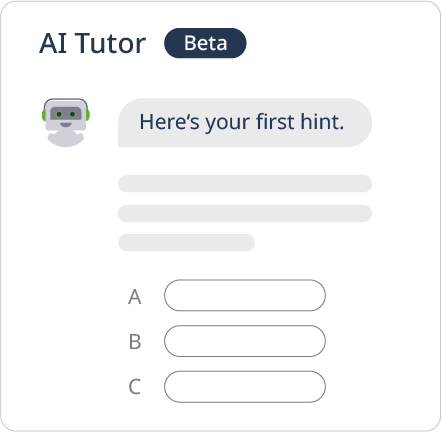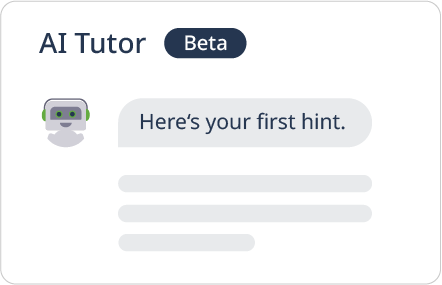Level up to NP with Lecturio's
Free FNP Practice Questions
Train clinical provider skills with cases curated for NPs by NPs





Practice with a powerful FNP Question Bank
Realistic questions and in-depth rationales prepare you for the AANP FNP certification exam and advanced clinical practice
3000+ questions
with detailed rationales for all answer choices
Related study materials
and engaging Video Lessons provided with every answer explanation
Based on the AANP blueprint
covering all domains and knowledge areas
Supporting AI tutor
giving optional hints and guides your thought process for even more efficient learning






The Lecturio platform is more than just a Qbank
Study with advanced learning methods and smarter technology






Try 10 free sample FNP questions
Tackle these FNP practice questions and many more by signing up today!
What is the primary consideration for the nurse practitioner treating a kidney infection in a primary care clinic when deciding to refer the patient to specialist care?
A. Severity and complexity of the infection
B. Availability of resources and diagnostic tools
C. Patient’s response to initial treatment
D. Nurse practitioner’s level of expertise and comfort in managing the condition
A middle adult woman with a history of iron-deficiency anemia has been prescribed oral iron supplements. She is also taking omeprazole for gastroesophageal reflux disease (GERD). The nurse practitioner teaches this patient to take this medication:
A. With a glass of milk to avoid stomach upset.
B. Separate from foods high in vitamin C.
C. With a glass of orange juice for enhanced absorption.
D. At the same time as the omeprazole to enhance absorption.
A nurse practitioner performs a general survey on an adolescent. Which of the following findings should trigger a more advanced assessment?
A. The adolescent maintains eye contact during the conversation.
B. The adolescent reports recent unintentional weight loss and fatigue.
C. The adolescent has grown 2 inches but weight is unchanged since the last yearly check-up.
D. The adolescent reports an increase in appetite but maintains a consistent weight.
Which of the following findings should the nurse practitioner be most vigilant for during the skin cancer screening of an adult male patient with a history of outdoor occupation and minimal use of sun protection?
A. Multiple comedones on the nose and forehead
B. Diffuse erythema and scaling on the trunk and extremities
C. Small, pearly papule with central ulceration and rolled elevated edges
D. A firm, brownish nodule on the left leg which makes a central dimple when pinched
Which of the following patient scenarios falls outside of the typical scope of practice for a family nurse practitioner?
A. Providing routine check-ups and vaccinations for an 8-year-old child.
B. Managing diabetes and hypertension medications for a 45-year-old adult.
C. Performing prenatal care and postpartum visits for expectant mothers.
D. Conducting psychotherapy sessions for individuals with anxiety disorders.
A nurse practitioner prepares to perform an otoscopic examination on a middle adult patient’s right ear. What is the correct technique for improving visualization of the ear canal during the examination?
A. Gently pull the outer ear up and back with the free hand.
B. Gently pull the outer ear down and back with the free hand.
C. Move the otoscope 1 to 2 cm forward before looking into it.
D. Insert the viewing piece of the otoscope several centimeters into the ear canal.
A 28-year-old woman presents with petechiae, easy bruising, and a platelet count of 12,000/mm³. She has no significant medical history and is not taking any medications. Physical examination reveals no other abnormalities. What is the most appropriate initial diagnostic test for this patient?
A. Bone marrow aspiration
B. HIV and HCV testing
C. Review of dietary history
D. Peripheral blood smear
Which one of the following is associated with type 2 but not type 1 diabetes?
A. Diabetic ketoacidosis (DKA)
B. Acne
C. Polyuria
D. Hyperosmolar hyperglycemic syndrome (HHS)
A young adult patient presents to the clinic with excessive worry, muscle tension, restlessness, and difficulty concentrating for the past six months. This has led to significant impairment in daily functioning. Which of the following is the most likely diagnosis based on these symptoms?
A. Major depressive disorder
B. Social anxiety disorder
C. Generalized anxiety disorder
D. Panic disorder
Which phase of biotransformation typically involves the conjugation of a drug or its metabolites to make them more water-soluble?
A. Phase I
B. Phase II
C. Phase III
D. Phase IV
FAQs
The AANP FNP exam consists of 150 questions covering three domains: assessment, diagnosis, and plan and evaluation.
To be optimally prepared, you should follow the clinical progression of the domains for each practice case and train your clinical thinking. Taking multiple practice tests is the best way to prepare.
Recertification requires a (verified) minimum amount of clinical practice hours, a certain amount of accredited continuing education hours, and an application submission which involves a fee. Alternatively to the clinical hours, you can take the AANP FNP recertification exam. Read more here.
Taking practice questions trains your stamina for test day and gets you familiar with the exam format. Additionally, actively applying your knowledge to practice cases prepares you for independent clinical practice better than any other study method.
Our student success stories speak for themselves: 93% of users would recommend it to a friend, 97% found that using Lecturio increased flexibility and convenience in their studying. See more success statistics –>
Yes, you can register your Lecturio account for free, with no obligations and no credit card required. Your free account gives you access to around 20% of the full content for an unlimited time. You can upgrade to a paid account with full access at any time. Additionally, we offer a 14-day free trial of Lecturio Premium for new users.